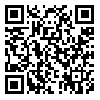BibTeX | RIS | EndNote | Medlars | ProCite | Reference Manager | RefWorks
Send citation to:
URL: http://jdisabilstud.org/article-1-3128-en.html
2- Associate Professor, Allameh Tabataba’i University, Tehran, Iran
3- Associate Professor, Iran University of Medical Sciences, Tehran, Iran
Abstract
Background & Objective: The Iranian deaf people use sign language in their interactions, a natural language that uses linguistic tools for encoding different concepts. There needs to be more evidence about the history of sign language in Iran, and few studies have been done so far. The sign language of Iran has been variously named by both hearing and deaf users, commonly called Zaban Eshareh Irani (ZEI). This research aimed to investigate the construction of possession in Iranian deaf sign language (Tehrani variant).
Methods: The research method in this research was qualitative and content analysis type. The study was descriptive (qualitative) and was based on the theoretical framework of the cross-linguistic research of Zashen & Pernis (2008), entitled Sign Language Typology: Possession and Existentials. The research participants, selected based on the purposeful sampling method, included seven congenitally profoundly deaf adults (4 women and three men) living in Tehran who had hearing aids and were 35-40 years old. All except one individual were employed, while the remaining was a student. Everyone in the group possessed literacy skills, ranging from diploma holders to PhD students in linguistics. They were introduced to sign language from an early age and regularly used the Tehrani variant of Iranian sign language in the family and social settings. All of these subjects could understand the spoken Persian language and understand and express it in writing. An interpreter and a sign language consultant were present at all stages of the research. The main method of data collection in this research was "observation" In order to collect data, the language behaviors of the signers during the presentation of linguistic stimuli were observed and video recorded. Linguistic stimuli (4 games and some pictures) of research were designed to not depend on culture and have a simple implementation method. Also, a targeted watching of films in Iranian sign language was carried out to obtain more spontaneous data. These data can be found in virtual social media such as Telegram and Instagram. About 120 minutes of Iranian Sign Language (Tehrani variant) were obtained for analysis. The data were entered into the ELAN software program for analysis.
Results: The data analysis showed that in Iranian sign language (Tehrani variant), possession marking can be seen as nominal and predictive possession (have & belong). This language uses personal and common pronouns in possessiveness without gender distinction. In this language, there are no special paradigms of possessive pronouns. Iranian sign language (Tehrani variant) does not use the obvious possession marking in the nominal possessive. The dominant word order in nominal possession is possessed-possessor (except in the relationship between part and whole). The Have-construction has the word order of possessor-possessum-predict, and the belong-construction has the order of possessum-Male-possessor-predict (the relative verbs can be omitted). In Iranian sign language, existential particles are used in the concept of possession. However, signs whose original meaning is related to "taking" or "grabbing" are not used for possession. Predicative quantifier/modifier construction could be found in Iranian sign language. Some further information is given about the possessed item, such as its quantity or some adjectival information; there is no overt sign expressing the possessive relationship. Also, being alienable, inalienable, animate, inanimate, concrete or abstract possession does not make a difference in the main construction of nominal possession and the have-construction, which is opposed to the belong- constructions, Because belong-construction are not used for kinship words ( (such as one's children), abstract concepts (such as time) or diseases and body parts. Spatial marking in possessive and existential constructions and possessive NPs were seen in different forms in this language.
Conclusion: In general, this research showed that Iranian Deaf sign language (Tehrani variant) has its grammatical structure in possession and can be recognized as a natural language. The results of the present study will be helpful for language planning, compiling textbooks and teaching sign language, linguistic research and presentation or explanation of linguistic theories. It is also helpful in expanding the scope of sign language linguistics in the fields of possession.
| Rights and permissions | |
 |
This work is licensed under a Creative Commons Attribution-NonCommercial 4.0 International License. |




